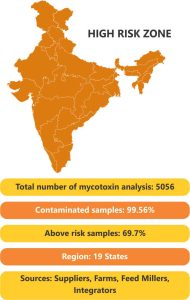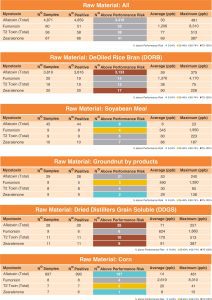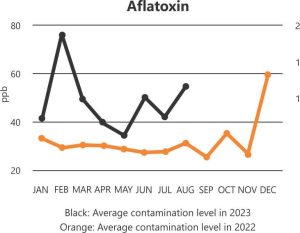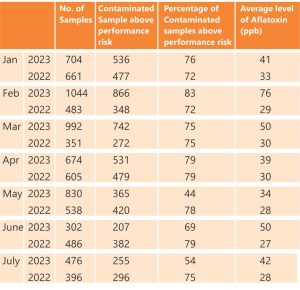Poultry feed production and cost are major issues faced by poultry industy in India. Raw

Key highlights of Mycotoxin Survey:
- India comes in high risk zone, as 50 – 74% analysed samples were above performance risk level for mycotoxin contamination.
- Aflatoxin is the most prevalent mycotoxin followed by Fumonisin, Zearalenone and T2. which all can reduce performance and increase disease incidence in Poultry industry. They exert their effects through alteration in nutrient content, absorption, and metabolism, changes in the endocrine function and suppression of the immune system
- Highly contaminated ingredients are: Deoiled Rice Bran (DORB, Dried Distillers Grain Soluble (DDGS), Corn Gluten Meal (CGM) and Pea Nut Meal. These ingredients should be used judiciously with precautions. Regular mycotoxin analysis should be conducted to know contamination levels for these ingredients.
- Moderately contaminated ingredients are: Corn, Soyabean Meal (SBM) and Broken Rice. Corn is major constitute of poultry feed & being used more than 50%, Therefore, low level of contamination in corn could be highly harmful for bird.


Exposure to mycotoxins is a worldwide concern as their occurrence is unavoidable and varies among geographical regions. Mycotoxins can affect the performance and quality of production and act as carriers putting human health at risk. There are various factors affecting degree of Mycotoxicosis.
Mycotoxin Mitigation Strategies
Multipronged strategies have to be curated for combating mycotoxin issue as there are various factors, which are affecting poultry at different level. Prevention is always better than cure.


Dr Madnawat: The recent Cargill Mycotoxin Survey consists mycotoxin analysis data from the following 19 states. Samples have been collected from suppliers, farms, feed millers & integrators. Therefore, captured data represents an overview of mycotoxin prevalence pattern in India from January’23 – July’23.
Telangana, Karnataka, Haryana, Maharashtra, Punjab, Tamil Nadu, Uttar Pradesh, Uttarakhand, Madhya Pradesh, Gujarat, Rajasthan, Andhra Pradesh, West Bengal, Bihar, Orissa, Jammu & Kashmir, Chhattisgarh, Jharkhand, and Kerala.
As per published data, India is in a high-risk zone, where, around 69% of analyses were above the performance risk level for poultry in India. The highest contamination of mycotoxins was found in West Bengal due to its conducive climate for fungi to proliferate. High temperatures, high humidity, and prolonged storage of raw materials in inadequate storage infrastructure contribute to the high contamination of mycotoxins.
Can you please present a comparative figure of last year’s analysis of aflatoxin contamination with the present one?
Dr Madnawat: As aflatoxin is the most prevalent mycotoxin in India & highly toxic to birds and consequently to human beings. So, we will deep dive into the aflatoxin contamination scenario in India & compare the contamination level with last year.




Which DDGS is more in use? Can you offer any suggestions on how to overcome the challenges that arise when utilizing DDGS?
Dr Madnawat: The DDGS from different sources like corn, rice, wheat, and sorghum are highly useful for livestock and poultry. It is considered a waste product, but it is a very cheap source of crude protein, crude fiber, available phosphorous, unsaturated fatty acids, and essential amino acids. Extra precautions should be taken while using DDGS with less than 30% crude protein because such kind of DDGS has been not processed & dried properly leading to high mycotoxin levels. In the recent Cargill Mycotoxin Survey, 100% of DDGS samples were found to be contaminated above the performance risk for poultry. Rice DDGS with more than 45% crude protein from standard vendors could be a good alternative source of protein because a low level of mycotoxin contamination has been observed in Rice DDGS. But it is advisable to conduct regular mycotoxin analysis before its use.
What is the assurance that using it will resolve the issue?
Dr Madnawat: More recent approaches include the use of a combination of binders, microbial enzymes, yeast cell walls, and natural antioxidants. Mycotoxin binder is one of the strategies to combat this issue and acts as insurance for poultry health. A mycotoxin binder is an inert substance that is added to animal feed in small quantities in order to trap mycotoxins, preventing them from entering the bloodstream where they can cause serious harm to animals.
Characteristics of a good mycotoxin binder:
- Broad-spectrum binding performance, as co-contamination of mycotoxin is prevalent, it is required to bind both polar and non-polar mycotoxin in an efficient way.
- Excretion of mycotoxins via faeces without any reaction within the body.
- Improvement in the performance of animals and recovery of organ status.
- Adsorption capacity towards a wide range of mycotoxins, in various pH conditions.
- Specificity: only binds mycotoxins not nutrients.
Nevertheless, complete avoidance of mycotoxins is not possible, as they are omnipresent & adopting the right mitigation strategies is key to combating them.















